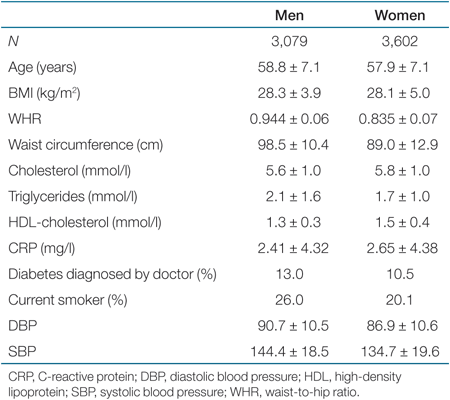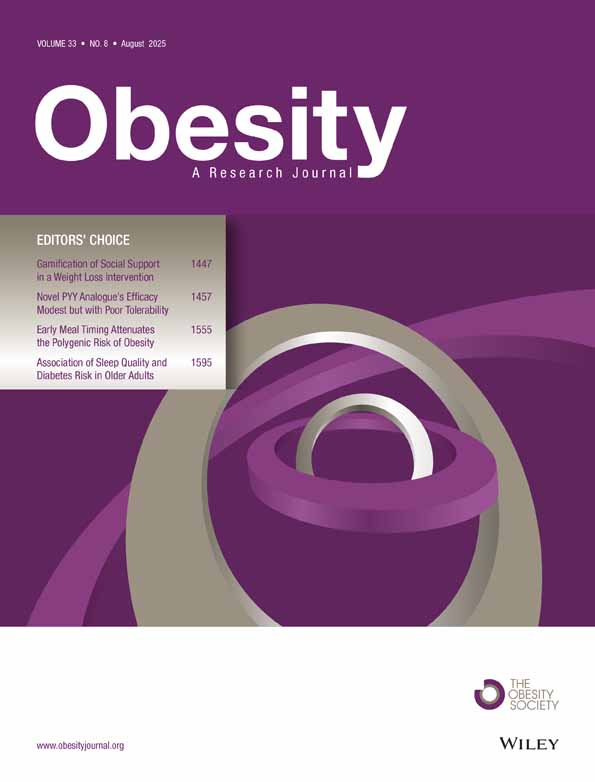The FTO Gene and Obesity in a Large Eastern European Population Sample: The HAPIEE Study
Abstract
Variants in the FTO (oxoglutarate-dependent nucleic acid demethylase) gene have been associated with the BMI determination in Western European and North American populations. To widen the geographical coverage of the FTO studies, we have analyzed the association between the FTO gene variant rs17817449 (G>C) and obesity in a Slavic Eastern European population. A total of 3,079 males and 3,602 females 45–69 years old were randomly selected from population registers of seven Czech cities. We examined three indices of obesity: BMI (kg/m2), waist circumference, and waist-to-hip ratio (WHR). The FTO rs17817449 variant was significantly associated with BMI both in males (GG 28.7 ± 4.1; GT 28.3 ± 3.9; TT 28.0 ± 3.9; P = 0.003) and females (GG 28.7 ± 5.2; GT 28.2 ± 5.1; TT 27.2 ± 4.9; P < 0.001); the associations were not affected by adjustment for age, smoking, socioeconomic status, and physical activity. The FTO variant was also associated with waist circumference (difference between GG and TT was 1.1 cm (P = 0.043) in men and 2.4 cm (P < 0.001) in women) but this relationship disappeared after adjustment for BMI. Similarly, BMI explained the weak association of FTO with WHR and C-reactive protein. FTO was not associated with plasma total and high-density lipoprotein cholesterol, triglycerides, blood glucose, and blood pressure. These results confirm that in a Slavic population the FTO variant is strongly associated with BMI but not with other risk factors.
Abundant energy intake and low physical activity are major causes of obesity on a population level, but studies on twins have clearly demonstrated that obesity also has an important genetic component of ∼70% (1). Recently, several genome-wide association studies identified variants in the FTO (fat mass and obesity associated) gene to be associated with BMI (2,3,4). The genome-wide association studies analyzed the variants rs9939609, rs1421085 and rs17817449, and alleles A (rs9939609), C (rs1421085), and G (rs17817449) were strongly associated with obesity phenotype. It has been shown that all three variants are in almost complete linkage disequilibrium. The FTO gene code for a 2-oxoglutarate-dependent-nucleic acid demethylase is widely expressed in human tissues (5). In wild-type mice, Fto mRNA is most abundant in hypothalamic nuclei governing energy balance (5). The more common obesity-protective allele of the FTO gene was found to be associated with increased adipocytes lipolytic activity in healthy women's adipocytes in vivo (6), but there was no significant association between Fto mRNA level and FTO gene variability.
Variants in the first intron of the FTO gene were associated with the BMI in the Western European and North American populations (2,3,4,7), but the Oceanic populations (8), Chinese (9), or African Americans (4) displayed no significant association between the FTO polymorphisms and BMI. To extend the investigation of the FTO gene in populations of different ancestry, we have conducted a study in 3,079 males and 3,602 females randomly selected from an ethnically homogenous Slavic population in Eastern Europe. We used data from the Czech part of the international HAPIEE (Health, Alcohol, Psychosocial factors In Eastern Europe) Project (10).
Results and Conclusions
Descriptive characteristics of the participants are shown in Table 1. The relatively high levels of cardiovascular risk factors are consistent with earlier findings in a Czech national population sample examined in the frame of the WHO MONICA Project (11).
 |
We found no evidence for deviation of genotype frequencies on the Hardy-Weinberg equilibrium, and both the genotype and allele frequencies were similar to the Western European and North American samples reported previously (2,3,4,7). The presence of the rs17817449 G allele was significantly associated with increased BMI in a linear fashion both in males and females (Table 2). The differences between the GG and TT genotypes in men and women were 0.7 and 1.0 kg/m2, respectively. Further adjustment for age, smoking, socioeconomic status, and physical activity did not change the results (not shown). The FTO variant was also associated with waist-to-hip ratio (WHR) and waist circumference, but this relationship was explained by BMI. For example, the unadjusted difference in waist circumference between the GG and TT genotypes was 1.1 cm in men and 2.4 cm in women; after controlling for BMI, however, these differences were reduced to −0.5 cm (reverse direction) and 0.2 cm, respectively, and the association was no longer statistically significant (not shown in table).
 |
There were no significant associations of the FTO gene with total, low-density lipoprotein (calculated) and high-density lipoprotein cholesterol, triglycerides, and fasting glucose (not shown). This is in contrast with a recent finding of the lower concentration of the high-density lipoprotein cholesterol and higher fasting glucose in the obesity-associated FTO genotype (7). In addition, it has been previously shown that high BMI correlated with elevated C-reactive protein levels (12). In our study we have detected the association between C-reactive protein and the FTO variant (P = 0.005) but, as with WHR and waist circumference, the association disappeared after adjustment for BMI. Similarly, there was a weak association between doctor-diagnosed diabetes and FTO (odds ratio for TT vs. GG 0.80, 95% confidence interval 0.64–1.00), but it was again explained by controlling for BMI.
The strength of the FTO genotype effect on BMI in this study was similar to results of previous reports. Earlier studies in whites found that each risk allele was associated with a BMI increase between 0.4 and 0.7 kg/m2, and homozygotes for the risk allele were approximately 0.9–1.2 kg/m2 heavier than those without a risk allele (13). Our findings are of similar magnitude, although in men the FTO effects were slightly weaker than those reported previously.
In conclusion, this first study in an Eastern European population, characterized by high levels of risk factors and a more recent onset of the cardiovascular disease epidemic (14), extends the evidence that the FTO variant is associated with obesity. Consistent with the previous results (13), the FTO variant was associated with BMI and other obesity indices. In this study, only the relation with BMI was independent; the associations with WHR and waist circumference, as well as with C-reactive protein and doctor-diagnosed diabetes, were explained by BMI.
Methods
The Czech HAPIEE cohort consists of a random sample of men and women aged 45–69 years old at baseline, stratified by gender and 5-year-age groups, and selected from population registers of the seven Czech towns (10). The ethics committees at both the Czech National Institute of Public Health and University College London approved the studies and all participants signed informed consents. A total of 8,856 subjects were recruited (response rate 55%). DNA samples were available from 6,827 of them; genotyping was successful in 6,681 persons.
Body height and weight, and waist and hip circumference were measured according to standardized protocols. BMI was calculated as weight (kg) over squared height (m). Plasma lipid parameters were analyzed by the WHO Regional Lipid Reference Centre, IKEM, Prague, on a Roche COBAS-MIRA autoanalyser, using reagents from Boehringer Mannheim Diagnostics and Hoffmann-La Roche. The FTO variants were also analyzed by PCR and restriction analysis in IKEM, Prague. Briefly, oligonucleotides 5′-ggtgaagaggaggagattgtgtaactgg-3′ and 5′-gaagccctgagaagtttagagtaaattggg-3′ with restriction enzyme AlwNI were used for the genotyping of rs17817449 FTO variant (uncut PCR product 198 bp represent allele G, restriction fragments of 99 bp and 99 bp allele T). In earlier genotyping analysis of a different sample of Czech subjects, the variant rs17817449 was in an almost complete linkage disequilibrium with the most often analyzed variant rs9939609 (D' 0.979, r2 0.94); this confirms the suitability of the rs17817449 variant in this population. The genotyping call rate was 97.9%. To ensure the accuracy of the method, one plate (94 samples) was genotyped twice within one week with 100% conformity.
The Hardy-Weinberg test was applied for the confirmation of the independent segregation of the FTO alleles. Descriptive values of risk factors levels are given as means ± standard deviations or proportions. The mean values of obesity indices by the FTO genotype are reported with their standard errors; the statistical significance of these differences was assessed by the analysis of variance. Odds ratios were estimated by logistic regression. Stata statistical software (version 9; College Station, TX) was used for the analyses.
Acknowledgment
This research was supported by grants by the Welcome Trust (064647/Z/01), the Ministry of Education, Youth and Sports of the Czech Republic (1M0510), the Institute of Clinical and Experimental Medicine (00023001), and the US National Institute of Aging (R01 AG23522-01).
Disclosure
The authors declared no conflict of interest.





